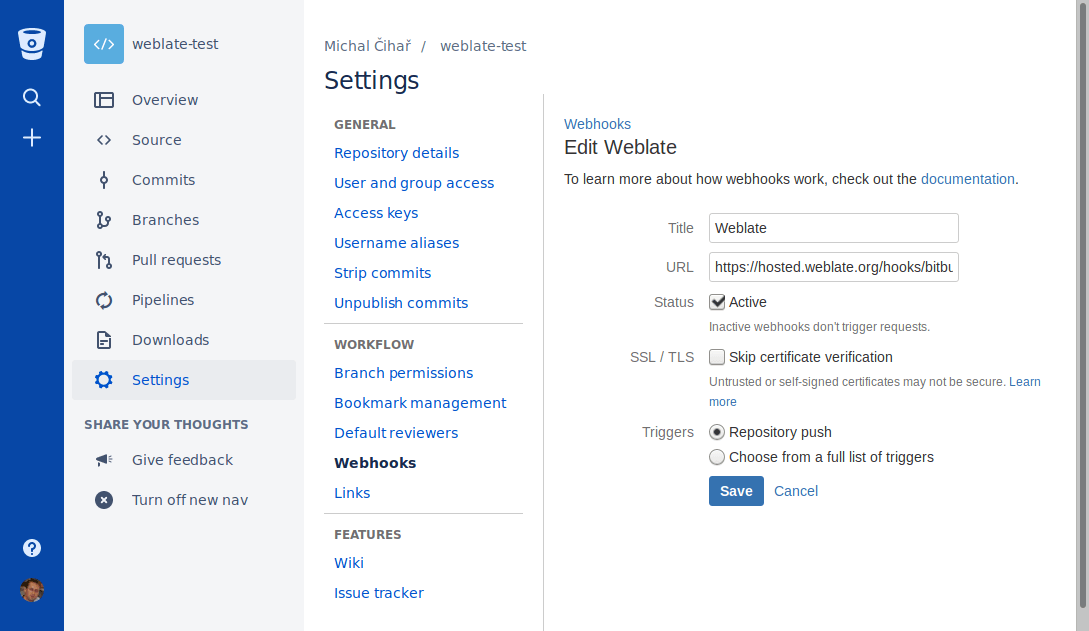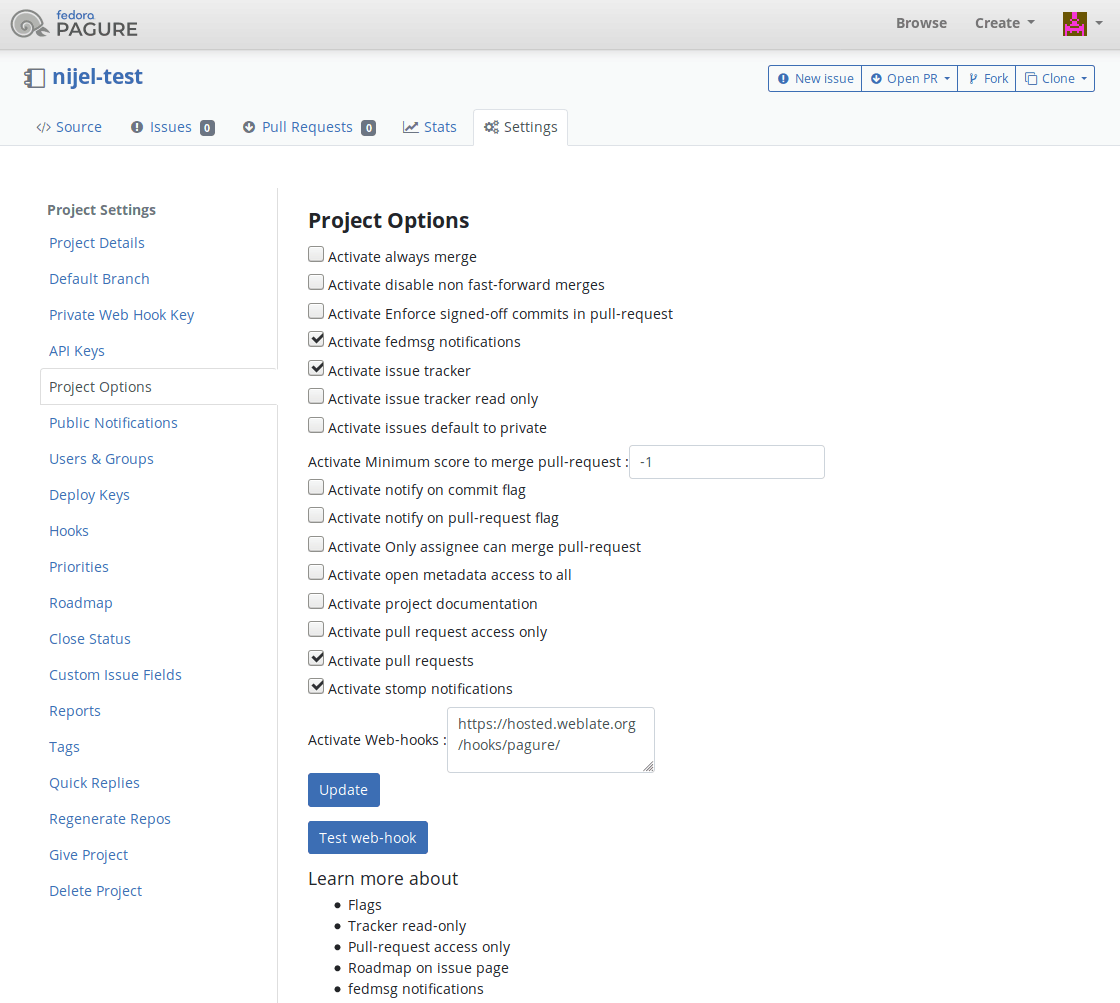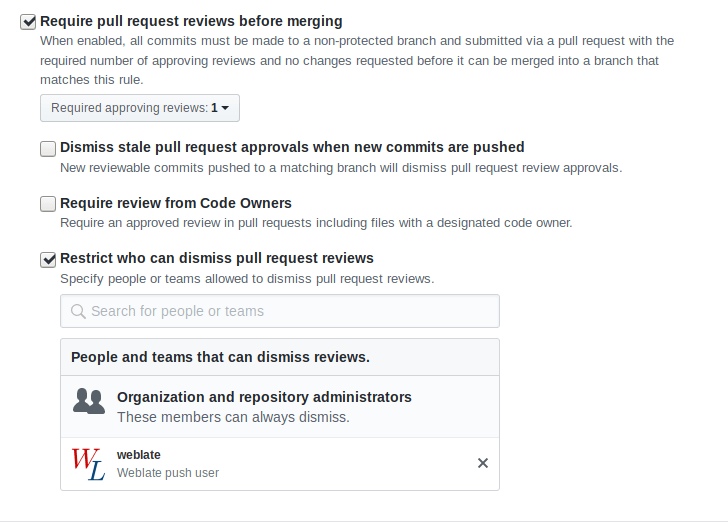Kontinuierliche Lokalisierung
There is infrastructure in place so that your translation closely follows development. This way translators can work on translations the entire time, instead of working through huge amount of new text just prior to release.
Siehe auch
Integrating with Weblate describes basic ways to integrate your development with Weblate.
This is the process:
Developers make changes and push them to the VCS repository.
Optionally the translation files are updated (this depends on the file format, see Why does Weblate still show old translation strings when I’ve updated the template?).
Weblate pulls changes from the VCS repository, see Updating repositories.
Once Weblate detects changes in translations, translators are notified based on their subscription settings.
Translators submit translations using the Weblate web interface, or upload offline changes.
Once the translators are finished, Weblate commits the changes to the local repository (see Lazy commits) and pushes them back if it has permissions to do so (see Pushing changes from Weblate).
Updating repositories
You should set up some way of updating backend repositories from their source.
Use Benachrichtigungs-Hooks to integrate with most of common code hosting services:
Manually trigger update either in the repository management or using Weblate’s REST API or Weblate Client
Enable
AUTO_UPDATEto automatically update all components on your Weblate instanceExecute
updategit(with selection of project or--allto update all)
Whenever Weblate updates the repository, the post-update addons will be triggered, see Erweiterungen.
Avoiding merge conflicts
Die Merge-Konflikte von Weblate entstehen, wenn dieselbe Datei sowohl in Weblate als auch außerhalb von Weblate geändert wurde. Es gibt zwei Möglichkeiten, damit umzugehen: Entweder Sie vermeiden Bearbeitungen außerhalb von Weblate oder Sie integrieren Weblate in Ihren Aktualisierungsprozess, so dass die Änderungen vor der Aktualisierung der Dateien außerhalb von Weblate geleert werden.
Der erste Ansatz ist bei einsprachigen Dateien einfach - Sie können neue Zeichenketten innerhalb von Weblate hinzufügen und die gesamte Bearbeitung der Dateien dort belassen. Für zweisprachige Dateien gibt es in der Regel eine Art von Nachrichtenextraktionsprozess, um übersetzbare Dateien aus dem Quellcode zu erzeugen. In manchen Fällen kann dies in zwei Teile aufgeteilt werden - einer für die Extraktion erzeugt eine Vorlage (z.B. gettext POT wird mit xgettext erzeugt) und ein weiterer Prozess fügt sie in die tatsächlichen Übersetzungen ein (die gettext PO-Dateien werden mit msgmerge aktualisiert). Sie können den zweiten Schritt innerhalb von Weblate durchführen. Weblate sorgt dafür, dass alle anstehenden Änderungen vor diesem Vorgang berücksichtigt werden.
Der zweite Ansatz kann erreicht werden, indem man Weblate’s REST API verwendet, um Weblate zu zwingen, alle anstehenden Änderungen zu pushen und die Übersetzung zu sperren, während man selbst Änderungen vornimmt.
The script for doing updates can look like this:
# Lock Weblate translation
wlc lock
# Push changes from Weblate to upstream repository
wlc push
# Pull changes from upstream repository to your local copy
git pull
# Update translation files, this example is for Django
./manage.py makemessages --keep-pot -a
git commit -m 'Locale updates' -- locale
# Push changes to upstream repository
git push
# Tell Weblate to pull changes (not needed if Weblate follows your repo
# automatically)
wlc pull
# Unlock translations
wlc unlock
If you have multiple components sharing same repository, you need to lock them all separately:
wlc lock foo/bar
wlc lock foo/baz
wlc lock foo/baj
Bemerkung
The example uses Weblate Client, which needs configuration (API keys) to be able to control Weblate remotely. You can also achieve this using any HTTP client instead of wlc, e.g. curl, see Weblate’s REST API.
Siehe auch
Automatically receiving changes from GitHub
Weblate comes with native support for GitHub.
Wenn Sie Hosted Weblate verwenden, empfiehlt es sich, die Weblate-App zu installieren, damit Sie die korrekte Einrichtung erhalten, ohne viel einrichten zu müssen. Sie kann auch zum Zurückschieben von Änderungen verwendet werden.
To receive notifications on every push to a GitHub repository, add the Weblate Webhook in the repository settings (Webhooks) as shown on the image below:

For the payload URL, append /hooks/github/ to your Weblate URL, for example
for the Hosted Weblate service, this is https://hosted.weblate.org/hooks/github/.
You can leave other values at default settings (Weblate can handle both content types and consumes just the push event).
Automatically receiving changes from Bitbucket
Weblate has support for Bitbucket webhooks, add a webhook
which triggers upon repository push, with destination to /hooks/bitbucket/ URL
on your Weblate installation (for example
https://hosted.weblate.org/hooks/bitbucket/).

Automatically receiving changes from GitLab
Weblate has support for GitLab hooks, add a project webhook
with destination to /hooks/gitlab/ URL on your Weblate installation
(for example https://hosted.weblate.org/hooks/gitlab/).
Automatically receiving changes from Pagure
Neu in Version 3.3.
Weblate has support for Pagure hooks, add a webhook
with destination to /hooks/pagure/ URL on your Weblate installation (for
example https://hosted.weblate.org/hooks/pagure/). This can be done in
Activate Web-hooks under Project options:

Automatically receiving changes from Azure Repos
Neu in Version 3.8.
Weblate has support for Azure Repos web hooks, add a webhook for
Code pushed event with destination to /hooks/azure/ URL on your
Weblate installation (for example https://hosted.weblate.org/hooks/azure/).
This can be done in Service hooks under Project
settings.
Automatically receiving changes from Gitea Repos
Neu in Version 3.9.
Weblate has support for Gitea webhooks, add a Gitea Webhook for
Push events event with destination to /hooks/gitea/ URL on your
Weblate installation (for example https://hosted.weblate.org/hooks/gitea/).
This can be done in Webhooks under repository Settings.
Automatically receiving changes from Gitee Repos
Neu in Version 3.9.
Weblate has support for Gitee webhooks, add a WebHook for
Push event with destination to /hooks/gitee/ URL on your
Weblate installation (for example https://hosted.weblate.org/hooks/gitee/).
This can be done in WebHooks under repository Management.
Automatically updating repositories nightly
Weblate automatically fetches remote repositories nightly to improve
performance when merging changes later. You can optionally turn this into doing
nightly merges as well, by enabling AUTO_UPDATE.
Pushing changes from Weblate
Each translation component can have a push URL set up (see
Push-URL für Repository), and in that case Weblate will be able to push change to
the remote repository. Weblate can be also be configured to automatically push
changes on every commit (this is default, see Bei Commit gleichzeitig Pushen).
If you do not want changes to be pushed automatically, you can do that manually
under Repository maintenance or using API via wlc push.
The push options differ based on the Integration der Versionsverwaltung used, more details are found in that chapter.
In case you do not want direct pushes by Weblate, there is support for GitHub-Pull-Anfragen, GitLab Merge Requests, Gitea pull requests, Pagure Merge Requests pull requests or Gerrit reviews, you can activate these by choosing GitHub, GitLab, Gitea, Gerrit or Pagure as Versionsverwaltung in Component configuration.
Overall, following options are available with Git, GitHub and GitLab:
Desired setup |
|||
|---|---|---|---|
No push |
empty |
empty |
|
Push directly |
SSH URL |
empty |
|
Push zu separatem Branch |
SSH URL |
Branch name |
|
GitHub pull request from fork |
empty |
empty |
|
GitHub pull request from branch |
SSH URL 1 |
Branch name |
|
GitLab merge request from fork |
empty |
empty |
|
GitLab merge request from branch |
SSH URL 1 |
Branch name |
|
Gitea merge request from fork |
empty |
empty |
|
Gitea merge request from branch |
SSH URL 1 |
Branch name |
|
Pagure merge request from fork |
empty |
empty |
|
Pagure merge request from branch |
SSH URL 1 |
Branch name |
- 1(1,2,3,4)
Can be empty in case Quellcode-Repository supports pushing.
Bemerkung
You can also enable automatic pushing of changes after Weblate commits, this can be done in Bei Commit gleichzeitig Pushen.
Siehe auch
See Accessing repositories for setting up SSH keys, and Lazy commits for info about when Weblate decides to commit changes.
Protected branches
If you are using Weblate on protected branch, you can configure it to use pull requests and perform actual review on the translations (what might be problematic for languages you do not know). An alternative approach is to waive this limitation for the Weblate push user.
For example on GitHub this can be done in the repository configuration:

Interacting with others
Weblate makes it easy to interact with others using its API.
Siehe auch
Lazy commits
The behaviour of Weblate is to group commits from the same author into one commit if possible. This greatly reduces the number of commits, however you might need to explicitly tell it to do the commits in case you want to get the VCS repository in sync, e.g. for merge (this is by default allowed for the Managers group, see Liste der Berechtigungen und integrierten Rollen).
The changes in this mode are committed once any of the following conditions are fulfilled:
Somebody else changes an already changed string.
A merge from upstream occurs.
An explicit commit is requested.
A file download is requested.
Change is older than period defined as Alter der Änderungen, das erreicht sein muss, bevor ein Commit erfolgt on Component configuration.
Hinweis
Commits are created for every component. So in case you have many components you will still see lot of commits. You might utilize Git-Commits konsolidieren add-on in that case.
If you want to commit changes more frequently and without checking of age, you can schedule a regular task to perform a commit:
CELERY_BEAT_SCHEDULE = {
# Unconditionally commit all changes every 2 minutes
"commit": {
"task": "weblate.trans.tasks.commit_pending",
# Omitting hours will honor per component settings,
# otherwise components with no changes older than this
# won't be committed
"kwargs": {"hours": 0},
# How frequently to execute the job in seconds
"schedule": 120,
}
}
Processing repository with scripts
The way to customize how Weblate interacts with the repository is Erweiterungen. Consult Ausführen von Skripten der Erweiterung for info on how to execute external scripts through add-ons.
Keeping translations same across components
Wenn Sie mehrere Übersetzungskomponenten haben, möchten Sie möglicherweise sicherstellen, dass die selben Zeichenketten dieselbe Übersetzung haben. Dies kann auf mehreren Ebenen erreicht werden.
Translation propagation
Wenn Verbreitung von Übersetzungen erlauben aktiviert ist (was die Voreinstellung ist, siehe Component configuration), werden alle neuen Übersetzungen automatisch in allen Komponenten mit übereinstimmenden Zeichenketten durchgeführt. Solche Übersetzungen werden dem aktuell übersetzenden Benutzer in allen Komponenten korrekt gutgeschrieben.
Bemerkung
The translation propagation requires the key to be match for monolingual translation formats, so keep that in mind when creating translation keys.
Consistency check
The Inkonsistent check fires whenever the strings are different. You can utilize this to review such differences manually and choose the right translation.
Automatische Übersetzung
Die automatische Übersetzung basierend auf verschiedenen Komponenten kann eine Möglichkeit sein, die Übersetzungen zwischen den Komponenten zu synchronisieren. Sie können es entweder manuell auslösen (siehe Automatische Übersetzung) oder es automatisch bei der Aktualisierung des Repositorys mit Hilfe einer Erweiterung laufen lassen (siehe Automatische Übersetzung).